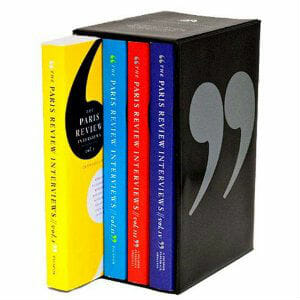
Thank goodness.
In the years since I began to publish fiction, fresh-faced young dreamers and writing wannabes, their numbers like grains of sand on the beaches, have approached me at conferences, coffee shops, bars, readings, libraries, restaurants and signings. Their shiny-dime eyes glow with hope. They seek a guru, a wisdom pill, a talisman. They awkwardly clear their throats to speak … and then always ask the Question.
“Mr. McNair, how do I get to be a writer?”
Only occasionally am I impatient, snapping some answer like, Well … have you tried putting the seat of the pants in the seat of the chair and writing till your fingernails are gone and you cry blood?
Now Picador gives me a better option. From now till infinity and beyond, when asked How do I get to be a writer?, I will say:
Get the collected Paris Review Interviews. Read them. Then put the seat of the pants in the seat of the chair and write like the writers in this indispensable collection.
Write like Capote, lying down in bed.
Write like Hemingway, standing up.
Whatever you do … write. You have tutorials here, in these wonderfully instructive pages.
It’s a collection for serious no-retreat, no-surrender writers. These interviews with the best and brightest of the world’s literary minds from the last six decades actually transubstantiate. They change into breakfast, lunch and supper. Want to write? Here’s the best nourishment money can buy.
Founding Paris Review editors Harold Humes, Peter Matthiessen and George Plimpton— yes that George Plimpton—put out the first issue of the influential quarterly in 1953. We’re closing in on 60 years of issues now, making The Paris Review one of our most important and enduring cultural publications. The Writers at Work series, where reviews in this compilation first appeared, stands on its own as a half-century seminar on great writing and how it gets done.
What’s in the interviews? You find the famous statement about writing given by Ernest Hemingway near the end of a grousing interview with young Plimpton, a line repeated so often, in so many MFA workshops in so many years, that its Parisian source has nearly been lost to antiquity:
“The most essential gift for a good writer is a built-in, shockproof, shit detector. This is the writer’s radar and all great writers have had it.”
What does Joan Didion think of screenwriting?
“It’s not writing. You’re making notes for the director …”
The great Nigerian writer Chinua Achebe (Things Fall Apart) on teaching creative writing?
“Many writers can’t make a living. So to be able to teach how to write is valuable to them. But I don’t really know about its value to the student … I wouldn’t have wanted anyone to teach me how to write. That’s my own taste. I prefer to stumble on it. I prefer to go on trying all kinds of things, not to be told, This is the way it is done.”
I recommend reading one of these interviews every night, like a devotional. Even the introductions to the interviews will inspire—they’re uniformly excellent, written by the very fine writers the review dispatched through the years to tap the brains of the masters.
I will also tell the young writer one more thing about this collection. As you read through its pages, you will feel the osmosis of literature, the seep into your DNA of will and zeal and patience and habit and technique and invention that make up genetic code of a writer.
You can read these pages to learn how to be a writer. And I can read them to learn how to be a better writer.
Thank goodness.
Charles McNair began work as Paste’s Books Editor in 2005. He is author of Land O’ Goshen.